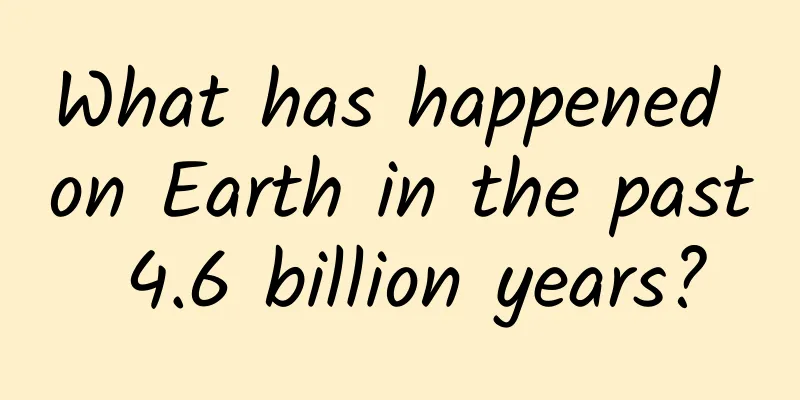What has happened on Earth in the past 4.6 billion years?

|
Speaking of the history of the Earth, it may be confusing and fascinating. The reason for the confusion is that the history of the Earth is too long (4.6 billion years), and human civilization is only a blink of an eye. But the Earth has not been boring in the long 4.6 billion years. It has experienced a series of major events such as the aggregation and separation of continents, the explosion and extinction of biological species, etc. It is fascinating and even memorable to explore the causes, processes and results of these events. Let’s review everything that has happened on Earth in the past 4.6 billion years! Part 1 Continental plates that will eventually separate after a long period of coming together, and will eventually come together after a long period of separation If I give you a torn newspaper, I believe you can always restore it and piece it together based on the text on the edge of the newspaper and the outline of each fragment. When you look at the world map, have you ever had the urge to piece together the pieces of land dotted on the boundless blue ocean into a seamless whole? There really was such a person in human history who, with his imaginative ideas, "torn" off the continents on the map and pieced them together like a great shift in the universe. He was the famous Alfred Wegener, the founder of the theory of continental drift. After step-by-step demonstration and research by Wegener and later geologists, the current plate tectonic theory was finally formed, that is, the surface of the earth is covered with non-deformable and solid plates (lithosphere), which move at a speed of 1 cm to 10 cm per year. As plates move and evolve, the continents on Earth have separated and merged throughout history, a cycle of united ancient continents. With the continuous aggregation of continents, supercontinents (united ancient landmasses) emerged. In geological history, there have been five united ancient landmasses, which were formed at about 2500Ma1, about 1900Ma, about 1400Ma, about 850Ma, and about 250Ma respectively. Note 1: Ma is a unit of years, representing 1 million years Lithospheric evolution diagram (356 Ma - next 150 Ma, Scotese, 1997) The united ancient land formed around 250 Ma is the closest to us. In terms of spatial distribution, the united ancient land presents a typical longitudinal hemispherical distribution. The land and sea distribution pattern we see today is formed by splitting and drifting on this basis. A large amount of earth science data shows that other major historical events that occurred along with the formation of this ancient land include: a large increase in land area, a sharp decrease in shallow sea area, climate cooling, sea level drop, oxygen-deficient sedimentation, volcanic eruptions, mass extinction of shallow sea organisms, etc. Therefore, plate movement is an important factor in a series of major events on Earth. Part 2 Mass extinction events In the solar system and even in the Milky Way, Earth is unique because it has a wide variety of life forms. Has life always existed throughout the long history of the Earth? French scientist Reeve gave us the answer through vivid description. If we compress the Earth's 4.6 billion years into one day, then: For the first 6 hours of the day, the earth is dead silent; At 6 a.m., the lowest algae began to appear in the ocean, and they lasted for quite a long time; It is not until 20:00 that mollusks begin to move in the oceans, lakes and swamps; At 23:30, the dinosaur appeared, but left the stage in a hurry after only 10 minutes; In the last 20 minutes of this day, mammals appeared and began to differentiate; At 23:50, our ancestors slowly appeared on the stage; In the last 2 minutes, their brains expanded and they became human. In Reeve's description, the earth is like a stage, where some people come on stage and some leave. Scientists call the extinction of organisms in different periods "extinction". In the geological history period, if multiple categories of organisms become extinct almost at the same time, this kind of extinction is called mass extinction. Its main characteristics are: the main categories of organisms or a large number of organisms suddenly disappear in a short period of time or at the same time, and the biological diversity and biomass suddenly decrease. According to statistics, there have been as many as 15 mass extinction events and five major mass extinction events in the history of the Earth. Major extinction events and changes in diversity of marine animals (according to Raup and Seokoski, 1982) (1) The first mass extinction event : Between 450 million and 440 million years ago, a 3 km thick layer of ice covered northern and central Africa, as well as parts of South America. This caused the ocean currents and atmospheric circulation to cool, and the entire Earth entered an ice age. 85% of species became extinct, including about 27% of families and 57% of genera. In terms of the number of extinctions, it ranks third among the five mass extinction events. (2) The second mass extinction event : 375 million to 360 million years ago, the climate turned cold again, and marine life once again suffered a great blow, while terrestrial life was less affected. About 82% of marine species became extinct, and almost all shallow-sea corals became extinct, and some deep-sea corals also became extinct. This event ranks fifth among the five mass extinction events. (3) The third mass extinction event : 251 million years ago (251 Ma), the sea level dropped, the ecosystem was severely damaged, and another mass extinction event broke out on Earth. This was also the most serious mass extinction event in the history of the Earth. A total of about 57% of families, 83% of genera, about 96% of marine life and 70% of terrestrial life became extinct. The animals that became completely extinct this time included trilobites, sea scorpions, important coral groups, terrestrial monocephalic animals and many reptile groups. (4) The fourth mass extinction event : 200 million years ago, all marine reptiles except ichthyosaurs became extinct, and half of the marine species disappeared. All terrestrial dinosaurs and most synapsids disappeared. Therodonts became extinct, and the surviving plants were conifers and cycads. It was this extinction event that provided dinosaurs with a vast living space, allowing them to become the dominant species on Earth for a period of time. This extinction event happened very recently, less than 10,000 years ago, and the cause of the extinction has not yet been determined. Volcanic eruptions, meteor impacts, and extreme cold weather are all possible culprits. (5) The fifth mass extinction event : 65 million years ago (65 Ma), the fifth mass extinction event broke out on Earth, and the extinction of dinosaurs occurred during this period. Particles in the atmosphere blocked the sunlight, and the number of plants that rely on photosynthesis decreased. Herbivorous dinosaurs suffered a great blow, and carnivorous dinosaurs also died due to lack of food. Coccoliths and mollusks suffered a serious blow. Omnivores, insectivores, and scavengers survived, such as crocodiles and mammals, and river communities were also preserved. This extinction event eventually led to the extinction of about 17% of families, 50% of genera, and 75% of species. The scale of this extinction event ranked second among the five mass extinction events. Are we humans about to witness our sixth major mass extinction event? According to a recent study published in Science magazine, an international team of scientists warned that the extinction and reduction of animals is the prelude to the sixth mass extinction of life on Earth. Since 1500, more than 320 terrestrial vertebrate species have become extinct one after another. The remaining species have also shown an average decline of 25%, and this situation is extremely similar in invertebrates. Although previous mass extinctions were caused by natural changes in the Earth or catastrophic asteroid impacts, today's extinction is closely related to human behavior. So we call on you to protect animals and our friends who live on Earth with us! Part 3 The Earth's magnetic pole makes you lose track of the north When traveling, hikers will definitely carry a compass with them. When they are deep in the mountains and cannot tell the direction, they will turn to it for help. The compass is calibrated with the help of the earth's magnetic poles. Today, the earth's magnetic north pole and geographic north pole are almost the same, so the compass can help us distinguish north and south. We all know that the Earth has north and south magnetic poles, and many people think that they are fixed. However, scientists have found that the magnetic poles of the Earth's magnetic field are not fixed, and have flipped several times in the past tens of millions of years. That is, the North Pole of the Earth's magnetic field becomes the South Pole of the Earth's magnetic field, and the South Pole of the Earth's magnetic field becomes the North Pole of the Earth's magnetic field. This is the so-called "magnetic pole reversal." This change in the magnetic poles of the Earth's magnetic field has always existed in the history of the Earth. If the history of the Earth is shortened to one day, during this period, you will find that the compass in your hand spins like crazy, sometimes pointing south and sometimes pointing north. However, the reversal of the magnetic poles is still slow on the scale of geological time, often with a cycle of thousands or tens of thousands of years. The above picture (quoted from NASA) is a model of the Earth's magnetic field in a supercomputer. The left side is the commonly seen geomagnetic field with two magnetic poles, which is the typical form in the long years between two reversals; the right side is a complex form in which the geomagnetic field undergoes drastic changes in a short period of time (relatively speaking) during the magnetic pole reversal process. How do we know that the magnetic poles change? Rocks from different geological eras often have a certain degree of magnetism, and these rocks can record the direction of the magnetic poles when they were formed. The figure below is a geological record, which shows the changes in the direction of the Earth's magnetic field over the past 160 million years. Black represents the same magnetic field as the current one, and white represents the opposite magnetic field. It can be seen from the figure that there is no fixed period for the reversal of the Earth's magnetic poles. Image from: Author's own Why do magnetic poles change? Is there any pattern in the repeated changes of the Earth's magnetic field? Scientists have not reached a unified view on this. Most scientists believe that when the liquid iron flow inside the earth flows around the center of the core, if it suddenly changes and its flow direction reverses, it will cause the magnetic pole reversal phenomenon. Part 4 Ice Age I believe everyone is familiar with the global cooling event. With the popularity of a series of movies such as "The Day After Tomorrow" and "Ice Age", we have witnessed the magnificent scene of global climate cooling and the powerful force of nature. Here I want to tell you that the Ice Age really appeared on Earth, and more than once. There have been three famous global and cross-regional climate cooling events in geological history, the most recognized of which are the Late Precambrian Glacial Age (about 500 Ma), the Carboniferous-Permian Glacial Age (350-250 Ma) and the Quaternary Glacial Age (about 10 Ma). The most important sign of the ice age is the global temperature drop, which caused the formation of large-scale ice sheets and mountain glaciers in the middle and high latitudes (including the cold polar regions during the ice age) and in the high mountain areas. As water was transferred from the ocean to the ice sheet area, the continental ice sheet continued to expand and thicken, causing the sea level to drop significantly. Therefore, the climate during the ice age was dry and cold. The existence of ice sheets and changes in the sea and land situation caused the climate zones to move accordingly, and the atmospheric circulation and ocean currents changed, which directly affected the growth, evolution and distribution of plants and animals. The causes of climate change or ice ages remain a "mystery" in the scientific community. Currently, scientists have proposed seven hypotheses about the causes of ice ages: 1. Caused by changes in the solar system's position in the universe. When the solar system passes through the cold regions of the universe as the Milky Way rotates, or when it moves to regions with dense cosmic dust particles, part of the solar radiation is absorbed by the cosmic dust, the solar radiation received by the earth decreases, the warmth decreases, and an ice age occurs on the earth. 2. The eccentricity of the Earth's orbit changes every 93,000 years, causing the distance between the Earth and the Sun to increase, or the Earth is attracted by Jupiter, causing the Earth's orbit to become circular (about once every 100,000 years), causing the distance between the Earth and the Sun to increase, reducing the Earth's warmth and forming an ice age. 3. Changes in the Earth's rotation speed cause crustal movement and changes in the polar atmosphere. For example, when the Earth's rotation speed increases, the cold atmosphere at the poles rushes toward the equator, and the climate becomes colder. 4. Strong crustal movement causes frequent volcanic activity, which emits a large amount of debris, blocking the sky and weakening the solar radiation. Strong crustal movement can also cause the continent to rise, exposing a large amount of new rocks to the air. Rock weathering reduces the carbon dioxide content in the atmosphere that protects the earth's heat from escaping, causing a drop in temperature, glacial activity, and an ice age. 5. Continental drift causes the positions of the continents relative to the poles to change in different periods. When moving closer to the poles, the climate is cold and ice ages occur, such as the Carboniferous-Permian Ice Age. Africa, Australia, South America, Antarctica and India were originally a complete ancient continent, and Africa was the South Pole at that time, and the North Pole was in the Pacific Ocean. Therefore, there were glacial movements in the ancient continents of the Southern Hemisphere at that time. 6. During the transition period when the Earth's north and south magnetic poles reverse relative to each other, the Earth's magnetic field is quite weak, the atmosphere is filled with electron-carrying particles and cosmic dust, the sunlight is blocked, the temperature drops, rain and snow occur intermittently for hundreds of years, and the ice age arrives. 7. When the cold waters of the Arctic Ocean communicate with the warm Pacific and Atlantic Oceans through the straits, the humid climate causes heavy snow to form an ice sheet over the Arctic Ocean, reflecting most of the solar radiation, causing the climate to become colder and the ice age to appear. Which hypothesis is more realistic? Are there other reasons? When will the next ice age come? These are all questions that need to be explored by humans. Part.5 Hypoxic events As we all know, oxygen is an important element for giving and maintaining life. It is conceivable what kind of disaster would be caused by a sudden drop in oxygen in an earth thriving with life. In geological history, large-scale anoxic event deposits mainly developed in the early Cambrian (about 500Ma), the transition between the Ordovician and Silurian (about 440Ma), the Late Devonian (about 360Ma), the Late Carboniferous-Early Permian (about 300Ma), the transition between the Permian and Triassic (about 250Ma) and the transition between the Triassic and Jurassic (about 200Ma). Except for the anoxic events in the early Cambrian and the Late Carboniferous-Early Permian, the other four events roughly coincide with the timing of the four mass extinctions mentioned above. Ocean hypoxia may be caused by a combination of factors, including climate conditions, ocean circulation, sea level fluctuations, and the location of continents. For example, some people believe that during warm periods, the temperature difference in the ocean meridian becomes smaller, the world's ocean currents stagnate, and a stagnation period is formed, which makes the ocean hypoxic layer thicker. The most direct factor for continental hypoxia may be the increase in carbon dioxide concentration. Over the past 400,000 years, the concentration of carbon dioxide in the atmosphere has been about 180 to 280 ppm (indicates the number of carbon dioxide molecules per million air molecules), but since the Industrial Revolution, the concentration of carbon dioxide has continued to rise, reaching an unprecedented 379 ppm in 2004. This concentration is already a quarter of the concentration of carbon dioxide during the Jurassic period when the severe greenhouse effect occurred. Experts say that if humans continue to allow the concentration of carbon dioxide to continue to increase, a greenhouse effect similar to that of the Jurassic period is likely to occur in 100 years, or even sooner. By then, the polar ice caps will melt, land will be reduced, temperatures will rise sharply, and a large number of species will become extinct. Anthony Cohen said, "Although this situation is an extreme climate event, it does not rule out the possibility of its occurrence. The key to the problem lies in the strength of our human efforts to control carbon dioxide emissions." Part 6 Visitors from outer space The Earth's growth process was not smooth. In addition to its own plate activities, magma activities, periods of hypoxia, global cooling, etc., it was also occasionally affected by external factors - asteroid impacts. According to the model published by scientists, the early Earth looked like a target in a shooting range. 4-4.5 billion years ago, the Earth's surface was repeatedly hit by asteroids. For the past three decades, scientists have debated what caused the extinction of the dinosaurs 65 million years ago - climate change, volcanic activity or an asteroid impact. Researchers have now confirmed that the extinction of the dinosaurs occurred at the same time as a 10-kilometer-long asteroid hit the Earth. The latest disaster prediction model shows that the asteroid collision will send vaporized rock particles into the Earth's atmosphere, turning the sky red and the temperature reaching 1,500 degrees Celsius. Douglas Robertson, a researcher at the Cooperative Institute for Research in Environmental Sciences (CIRES), said: "It is likely that the infrared heat is equivalent to a one-megaton hydrogen bomb exploding within a 6.4-kilometer radius of the entire Earth, equivalent to the explosive power of 80 atomic bombs." The Earth we live on has experienced many major events in its long evolution. It is precisely because it has withstood plate movement, volcanic eruptions, global cooling, biological extinction, and asteroid impacts that the Earth today shows magnificent mountains and rivers and colorful life. So we don’t have to sigh for the many disasters that the Earth has suffered in the past, but we must always be vigilant and not bring the next disaster to the Earth because of human development. Let us protect the Earth, our common beautiful home, from today! Produced by: Science Popularization China Author: Kansai Science and Technology Industry Research Institute Producer: China Science Expo This article only represents the author's views and does not represent the position of China Science Expo This article was first published in China Science Expo (kepubolan) |
Recommend
Did you know? Protecting dental health should start from primary and secondary school students!
Author: Tang Qin, Deputy Secretary-General and Re...
Tavistock short-term dynamic therapy twelve-lecture online course complete set of materials
Tavistock Short-Term Dynamic Therapy 12-Lecture O...
13 Marketing Keywords for the First Half of 2021
2021 is already halfway through. Looking back at ...
Android multi-process communication - in-depth understanding
[[405775]] 1. What is multi-process? Normally, in...
LeTV's new cross-border logic
Spielberg, a famous Hollywood director , cried fo...
2020 China Advertising Agency Map
Recently, independent marketing consulting compan...
Why is it so hard to keep a secret?
"I only told you this, don't tell anyone...
Super complete! All the advertising strategies for 2018 are here!
According to the data from the "2018 China O...
Creating Animated Google Maps Markers with CSS and JavaScript
one, Introduction The Google Maps API allows web ...
Why do we sometimes have to wait for half an hour for a bus that runs every 10 minutes?
Commuting is a topic that modern people cannot av...
What kind of river is the Tarim River? Learn more in this article →
“Tarim River, the river of my hometown, how many ...
How to protect yourself after the COVID-19 "B-tube"? Please keep this guide!
Source: Healthy China The cover image of this art...
Analysis of the rules of Xiaohongshu's deduction mechanism
After more than a month of rumors, the shoe final...
How to motivate new users? Take Meituan as an example
I believe most of you know the significance of ne...
Computers are racing: Millions of CPUs are fighting in clusters! Powerful supercomputers...
Produced by: Science Popularization China Author:...









